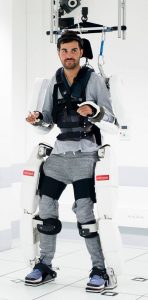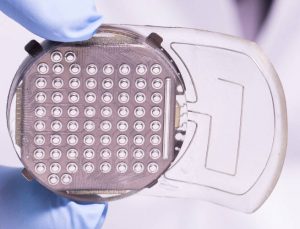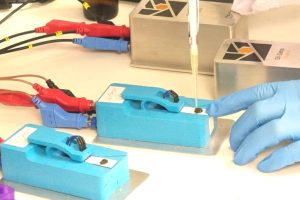
The brain connection is through a ‘semi-invasive’ medical device called Wimagine, developed at French lab CEA – specifically its Clinatec laboratory in Grenoble, which worked with Grenoble university hospital.
Wimagine has 64 electrodes and collects signals from the surface of the brain – on the brain, but in the cranium: hence semi-invasive.
It was designed be fitted over the sensorimotor cortex to detect electrocorticograms (ECoG) emitted when the subject imagines moving. The electrocorticograms are decoded using artificial intelligence algorithms.
 “This device is an important step forward in helping people with disabilities become self-sufficient,” according to researcher Alim-Louis Benabid. “We are extremely proud of this proof of concept and are already considering new applications to make everyday life easier for people with severe motor disabilities.”
“This device is an important step forward in helping people with disabilities become self-sufficient,” according to researcher Alim-Louis Benabid. “We are extremely proud of this proof of concept and are already considering new applications to make everyday life easier for people with severe motor disabilities.”
Two Wimagine devices were implanted into the volunteer two years ago, one on the left side of the upper sensorimotor area of the brain and the other on the right.
He has spent the subsequent 27 months performing exercises to practice controlling the exoskeleton, progressively operating more degrees-of-freedom. Currently he can operate up to eight degrees-of-freedom simultaneously, the exoskeleton has 14 joints.
“He practices in virtual environments with the exoskeleton avatar at home three times a week and works directly with the exoskeleton at Clinatec one week every month,” according to Clinatec. “When fitted with the suspended exoskeleton, he is able to take several successive steps and control his two upper limbs in three dimensions. He also can rotate his wrists while sitting or standing.”
Progress to date was reported in the Lancet paper ‘An exoskeleton controlled by an epidural wireless brain–machine interface in a tetraplegic patient: a proof-of-concept demonstration‘.
According to the paper abstract, 64% of virtual walking or upper limb movements were successful, and 71% of exoskeleton attempts on eight-dimensional tasks. Decoding algorithms could work for ~7 weeks without calibration.
Research is to continue, with the volunteer continuing to offer his services. “The Clinatec team is working on integrating new effectors, such as a wheelchair, and developing algorithms to perform more complex movements, with the hope of later enabling tasks such as holding an object,” said the lab. “Three other tetraplegic patients will also be included in this clinical trial in the coming years.”
 Electronics Weekly Electronics Design & Components Tech News
Electronics Weekly Electronics Design & Components Tech News



